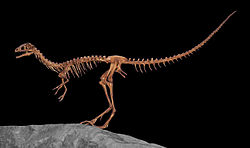Compsognathus longipes
|
Compsognathus Temporal range: Late Jurassic, 150.8 Ma |
|
|---|---|
 |
|
| Reconstruction of a skeleton, Museum of Ancient Life – Thanksgiving Point | |
| Scientific classification | |
| Kingdom: | Animalia |
| Phylum: | Chordata |
| Class: | Reptilia |
| Clade: | Dinosauria |
| Order: | Saurischia |
| Suborder: | Theropoda |
| Family: | †Compsognathidae |
| Subfamily: |
†Compsognathinae Cope, 1875 |
| Genus: |
†Compsognathus Wagner, 1859 |
| Type species | |
|
†Compsognathus longipes Wagner, 1859 |
|
| Synonyms | |
|
Compsognathus corallestris |
|
Compsognathus corallestris
Bidar, Demay, & Thomel, 1972
Compsognathus (/kɒmpˈsɒɡnəθəs/;Greek kompsos/κομψός; "elegant", "refined" or "dainty", and gnathos/γνάθος; "jaw") is a genus of small, bipedal, carnivorous theropod dinosaurs. Members of its single species Compsognathus longipes could grow to the size of a turkey. They lived about 150 million years ago, the Tithonian age of the late Jurassic period, in what is now Europe. Paleontologists have found two well-preserved fossils, one in Germany in the 1850s and the second in France more than a century later. Today, C. longipes is the only recognized species, although the larger specimen discovered in France in the 1970s was once thought to belong to a separate species and named C. corallestris.
Many presentations still describe Compsognathus as "chicken-sized" dinosaurs because of the small size of the German specimen, which is now believed to be a juvenile. Compsognathus longipes is one of the few dinosaur species for which diet is known with certainty: the remains of small, agile lizards are preserved in the bellies of both specimens. Teeth discovered in Portugal may be further fossil remains of the genus.
Although not recognized as such at the time of its discovery, Compsognathus is the first theropod dinosaur known from a reasonably complete fossil skeleton. Until the 1990s, it was the smallest known non-avialan dinosaur; earlier it had been incorrectly thought to be the closest relative of Archaeopteryx.
...
Wikipedia
